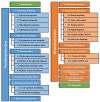Biomedical Applications of Titanium Alloys: A Comprehensive Review
- PMID: 38203968
- PMCID: PMC10780041
- DOI: 10.3390/ma17010114
Biomedical Applications of Titanium Alloys: A Comprehensive Review
Abstract
Titanium alloys have emerged as the most successful metallic material to ever be applied in the field of biomedical engineering. This comprehensive review covers the history of titanium in medicine, the properties of titanium and its alloys, the production technologies used to produce biomedical implants, and the most common uses for titanium and its alloys, ranging from orthopedic implants to dental prosthetics and cardiovascular devices. At the core of this success lies the combination of machinability, mechanical strength, biocompatibility, and corrosion resistance. This unique combination of useful traits has positioned titanium alloys as an indispensable material for biomedical engineering applications, enabling safer, more durable, and more efficient treatments for patients affected by various kinds of pathologies. This review takes an in-depth journey into the inherent properties that define titanium alloys and which of them are advantageous for biomedical use. It explores their production techniques and the fabrication methodologies that are utilized to machine them into their final shape. The biomedical applications of titanium alloys are then categorized and described in detail, focusing on which specific advantages titanium alloys are present when compared to other materials. This review not only captures the current state of the art, but also explores the future possibilities and limitations of titanium alloys applied in the biomedical field.
Keywords: 3D printing; biocompatibility; cardiovascular devices; dental implants; orthopedics; osseointegration; titanium alloys.
Conflict of interest statement
The authors declare no conflict of interest.
Figures








Similar articles
-
A state-of-the-art review of the fabrication and characteristics of titanium and its alloys for biomedical applications.Biodes Manuf. 2022;5(2):371-395. doi: 10.1007/s42242-021-00170-3. Epub 2021 Oct 26. Biodes Manuf. 2022. PMID: 34721937 Free PMC article. Review.
-
A Review of Past Research and Some Future Perspectives Regarding Titanium Alloys in Biomedical Applications.J Funct Biomater. 2025 Apr 18;16(4):144. doi: 10.3390/jfb16040144. J Funct Biomater. 2025. PMID: 40278252 Free PMC article. Review.
-
A comprehensive review of biological and materials properties of Tantalum and its alloys.J Biomed Mater Res A. 2022 Jun;110(6):1291-1306. doi: 10.1002/jbm.a.37373. Epub 2022 Feb 13. J Biomed Mater Res A. 2022. PMID: 35156305 Review.
-
Surface modification of titanium and titanium alloys by ion implantation.J Biomed Mater Res B Appl Biomater. 2010 May;93(2):581-91. doi: 10.1002/jbm.b.31596. J Biomed Mater Res B Appl Biomater. 2010. PMID: 20127988 Review.
-
Surface modification techniques of titanium and titanium alloys for biomedical orthopaedics applications: A review.Colloids Surf B Biointerfaces. 2023 Jul;227:113339. doi: 10.1016/j.colsurfb.2023.113339. Epub 2023 May 9. Colloids Surf B Biointerfaces. 2023. PMID: 37182380 Review.
Cited by
-
Electrolytic Routes to Titanium: Methodological Innovations, Key Findings, and Prospects for Sustainable Production.Materials (Basel). 2025 Jan 23;18(3):525. doi: 10.3390/ma18030525. Materials (Basel). 2025. PMID: 39942191 Free PMC article. Review.
-
Impact of Titanium Plate Fixation on Diacylglycerol and Growth Factor Levels in the Periosteum of the Mandible and Maxilla in Patients with Dentofacial Deformities After Jaw Osteotomies.Int J Mol Sci. 2025 Feb 26;26(5):2020. doi: 10.3390/ijms26052020. Int J Mol Sci. 2025. PMID: 40076643 Free PMC article.
-
Corrosion Behavior of Shot Peened Ti6Al4V Alloy Fabricated by Conventional and Additive Manufacturing.Materials (Basel). 2025 May 14;18(10):2274. doi: 10.3390/ma18102274. Materials (Basel). 2025. PMID: 40429011 Free PMC article.
-
Optimizing Suitable Mechanical Properties for a Biocompatible Beta-Titanium Alloy by Combining Plastic Deformation with Solution Treatment.Materials (Basel). 2024 Nov 27;17(23):5828. doi: 10.3390/ma17235828. Materials (Basel). 2024. PMID: 39685263 Free PMC article.
-
Evolution of Metals and Alloys in Orthopedics with Their Relevance in Osteoporosis.Indian J Orthop. 2025 Mar 14;59(3):271-279. doi: 10.1007/s43465-025-01344-2. eCollection 2025 Mar. Indian J Orthop. 2025. PMID: 40201922
References
-
- Blackwood D.J. Biomaterials: Past Successes and Future Problems. Corros. Rev. 2003;21:97–124. doi: 10.1515/CORRREV.2003.21.2-3.97. - DOI
-
- Elias C.N., Fernandes D.J., de Souza F.M., Monteiro E.D.S., de Biasi R.S. Mechanical and Clinical Properties of Titanium and Titanium-Based Alloys (Ti G2, Ti G4 Cold Worked Nanostructured and Ti G5) for Biomedical Applications. J. Mater. Res. Technol. 2019;8:1060–1069. doi: 10.1016/j.jmrt.2018.07.016. - DOI
-
- Tomashov N.D., Altovsky R.M., Chernova G.P. Passivity and Corrosion Resistance of Titanium and Its Alloys. J. Electrochem. Soc. 1961;108:113. doi: 10.1149/1.2428023. - DOI
Publication types
LinkOut - more resources
Full Text Sources

